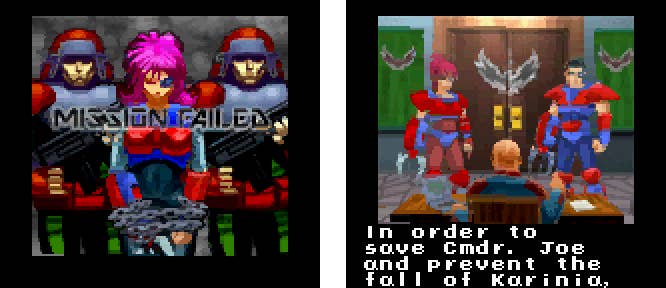Daily Classic: Bionic Commando Elite Forces and the Cycle of Rebirth
A mostly-forgotten Game Boy Color adventure that felt like a foretaste of the modern age.
This article first appeared on USgamer, a partner publication of VG247. Some content, such as this article, has been migrated to VG247 for posterity after USgamer's closure - but it has not been edited or further vetted by the VG247 team.
Stop me if any of this sounds familiar: A great game shows up on tons of platforms, enjoys a few different incarnations and sequels, then vanishes for years. Some time later, its publisher taps into the series' enduring fan base by tapping an outside developer to revitalize the series with a new entry, which turns out to be something of a sequel yet also something of a remake of a previous game.
Yep, that's pretty much every classic franchise these days. Just check the past month's release schedule: Lara Croft had her third reboot with Tomb Raider: Definitive Edition, Castlevania's reboot trilogy comes to an end with Lords of Shadow the same day that Looking Glass' Thief series is effectively relaunched with the Eidos-developed Thief, and let's not forget Strider. But I'm not talking about any of those series. I'm looking into the mists of the past, all the way back to 1999, when Capcom helped pioneer gaming's tritest trend this side of QTEs with a Game Boy Color adventure called Bionic Commando: Elite Forces.

The original Bionic Commando -- or rather, the 1988 NES game -- is, if I may say so, one of the greatest platform action games ever. Unique mechanics, excellent level design, and the merest hint of RPG influences combined to create a truly remarkable adventure that remains so engrossing that a more-or-less straight remake (Bionic Commando: Rearmed) was one of 2008's best game releases. Yet aside from a cosmetically revamped Game Boy port, Capcom never really did much with Bionic Commando for the following decade, relegating it to "cult classic" status.
So, perhaps it's understandable that they'd bring back the series more than 10 years later. At the time, Capcom was helping to lead the charge of NES reissues on Game Boy Color, back in those grim days before inexpensive digital distribution for classic games. Virtual Console may be a disappointment on many levels, but it sure beats paying $30 for a sloppy port of Micronic's NES sloppy port of Ghosts 'N Goblins. For some strange reason, though, Capcom wasn't happy to simply dredge up the old NES game and shoehorn it onto the handheld. Instead, they contracted with Nintendo's new U.S.-based internal development studio, Nintendo Software Technology, to create a more-or-less new game altogether.
A strange approach, perhaps, but not an entirely bad one. While Elite Forces somewhat missed the high mark set by its predecessor, it managed to be fairly decent. Its flaws were pretty obvious: The tiny Game Boy Color screen proportions hindered the level design, since the designers opted for large character sprites rather than the tiny little midget who swung through the earlier NES-to-Game Boy port. With such large characters, Elite Forces suffered from the Metroid II issue of having heroes capable of moving well beyond the boundaries of the Game Boy screen in a single motion — and frankly, it was a more egregious flaw here than in Metroid II, since the fundamental premise of Bionic Commando requires players to chain together multiple consecutive swings. When those become blind leaps of faith, challenge quickly mutates into frustration. The big, elaborately animated sprites brought with them a second issue as well: Their detailed animation cycles caused the game to run rather sluggishly compared to previous Bionic Commandos.

On the other hand, Elite Forces did offer plenty to like. It pushed the technological limits of the Game Boy Color hardware, not only offering some of the most elaborate graphics and animation yet seen on the system, but also using sophisticated techniques like sub-pixel tricks that added enhanced color depth in cut scenes while making the game notoriously difficult to emulate. It included some shooting gallery-like sniping sequences to break things up, similar to those of Shiny's MDK. You could even play as a female character, who proved to be every bit as capable as her male counterpart in a Resident Evil separate-but-equal sort of way. That put Elite Forces far ahead of the later GRIN-developed Bionic Commando games, which tended to gave its female characters the full-on refrigerator treatment to enhance the angst of manly protagonist Nathan Spencer.
Most of all, though, Elite Forces offered Bionic Commando fans their first taste of new content in more than a decade. After years of playing through the NES game and occasionally slumming it with the good-but-not-great arcade original, the new scenarios and settings in Elite Forces felt like a breath of fresh air. Granted, it was cast very much in the mold of the NES game, not only revolving around the same basic "save Super Joe, then stop Project Albatross" premise but even throwing in those top-down combat scenes Capcom had added to the NES game to create a stronger tie to the original Commando. But roaming through new environments (jungles, cities, even deserts) with original level layouts gave new vitality to a stagnant series, even if the new material wasn't as clever or polished as the game that inspired it.
Ultimately, Elite Forces amounted to little more than a blip in history – an oddity Capcom didn't even care to release outside the U.S. Underwhelming as it may have been, though, it helped keep the Bionic Commando alive long enough to inspire the Rearmed games, and that's a pretty respectable legacy.








